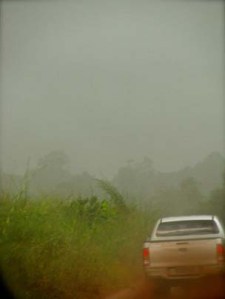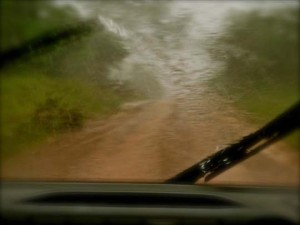The production of Tipping Point was an amazing adventure for the CCTV America crew. Correspondent Sean Callebs offers this behind the scenes view of their adventure on the journey to meet the Kayapo tribe.
Brazil is an amazing country, and we got to see a great deal of the rain forest. A couple of things really stand out. One, was a teeth-jarring 10-hour trip in a four-wheel drive truck to reach federal land set aside for the Kayapo, an indigenous tribe in the heart of the jungle.
To set the stage, there were seven adults, and a wealth of TV gear crammed into our two vehicles. That doesn’t leave a lot of wiggle room for the people. The first couple of hours of the drive from Colidor to the indigenous land was on a two lane highway. Fairly uneventful, except one of the road kill victims we saw was a panther and the boredom being broken every now and then by white-knuckle terror as we unwillingly played a game of chicken with oncoming traffic as we tried to pass a slow moving truck.
The real star of this trip was a seemingly unending muddy road that led to the Xingu River, and Kayapo country. Our trucks were driven by our two local hires from Manaus. 40-something Marco Lima, an army veteran turned marine biologist and his 20-something nephew Luciano Patillo, who we quickly dubbed Lucky.
 We slogged along 20 mph or so most of the time, occasionally fishtailing in the mud, or bouncing through a puddle. Well, they called it a puddle –to me it was quite often a small pond. After five or so hours of this, we realized we wouldn’t make it to Kayapo land. It was pouring the rain (imagine, in the rain forest). It was dark, and we had word that the one barge we needed to ferry us across the Xingu was broken.
We slogged along 20 mph or so most of the time, occasionally fishtailing in the mud, or bouncing through a puddle. Well, they called it a puddle –to me it was quite often a small pond. After five or so hours of this, we realized we wouldn’t make it to Kayapo land. It was pouring the rain (imagine, in the rain forest). It was dark, and we had word that the one barge we needed to ferry us across the Xingu was broken.
We made the trip with one of the leaders of the Kayapo, Megaron, and his wife. Megaron said he knew a place we could spend the night. Mind you, we had not seen any kind of structure in hours. But out of the darkness we saw this dilapidated large wooden building. It was a place to get some food, and also a place that truckers who travel the muddy road can get a night’s sleep. But no rooms for us. The owner didn’t like Megaron, or Kayapo Indians, and he sent us back in to the rain, and the dark.
We found a very similar pseudo-hotel-restaurant a few kilometers down the road. It was still
pouring. The building had an open air porch, a bar, a kitchen with a wood-burning stove and three rooms to rent. Photographer Andrew Smith said it reminded him of a “..little house of horrors.” Megaron and his wife had one room. Lucky and Marco bunked up (sleeping with their machetes by the way) Andrew, producer Hakan Ozsancak, and I took the third room. Our room had three children’s bunk-beds complete with “Little Mermaid” sheets, you know from the Disney movie. A light bulb dangled by an electric cord from the ceiling and rain found its way in through every nook and cranny.
The proprietor whipped up dinner, some rice and beans. We watched this gully-washer of a storm saturate everything around us. Some truckers mingled, foregoing dinner but did prove they could punish a bottle a two. None of us got any real sleep and hit the road (such as it was) at six a.m. We ambled for a few more hours through mud and slop, and about the time I thought we would never reach the river we came across a massive line of trucks. They had been waiting –days – to get their goods across the river. But the barge was not working. We, however, had Megaron, and he was able to get a note across the river and in a couple of hours we had a small armada of johnboats taking us, and our TV gear across the river and to the village.
24-hours after our “ten-hour” drive started –we were there. Exhausted, water-logged, and not sure if our gear would work. But we had already muddled through an amazing trip, and knew things would only get better. After all we had four days with the Kayapo, and it had stop raining some time, right?
 CGTN America
CGTN America

